January 2024 Newsletter
Sign up to receive our Center Newsletter!
CENTER, STAFF, AND TRAINEE NEWS
FEATURE ARTICLES
GenX Exposure Study collects new samples from study participants
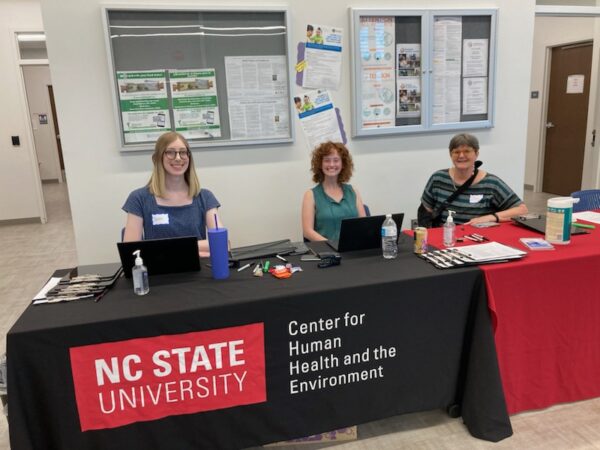
Jane Hoppin at the check-in table
The GenX Exposure Study is transitioning from an exposure study to a health study. In 2020-2021, the GenX Exposure Study team enrolled 1,020 people throughout the Cape Fear River Region (New Hanover and Brunswick Counties, Fayetteville private well community, and Town of Pittsboro) for a study to evaluate the long-term health effects associated with PFAS exposure. These communities have different profiles of PFAS exposure from drinking water, with some exclusively exposed to historically used PFAS (e.g., PFOA, PFOS), while others were exposed to both historically used PFAS as well as per- and polyfluoroether acids (PFEAs) associated with chemical production near Fayetteville, NC.

This Fall, the study team recontacted those individuals to complete a follow-up clinic visit, where the team collects new blood samples to analyze for PFAS and clinical outcomes (lipids, thyroid hormones, comprehensive metabolic panel), administers questionnaires, and measures body composition. Continued participation of all cohort members at follow-up visits is critical to improving our understanding of PFAS exposure and long-term health effects. Many participants have expressed that a key benefit of their participation has been the ability to monitor their own PFAS levels over time and to discuss their results with their physician. Two participants recorded a brief video message about why they chose to continue participating in the GenX Exposure Study – click here to watch their video! The study team plans to report back the latest round of individual clinical and PFAS results to participants in late 2023 and early 2024.
These clinic events are held in close collaboration with numerous community partners, health departments, and volunteers from the communities and local universities – the study team is grateful to these groups and individuals for their support of this research. You can learn more about Project 1 here and stay up-to-date on the GenX Exposure Study here.
Bringing a Community Perspective to Capitol Hill: National PFAS Contamination Coalition (NPCC) Members Advocate for Stricter PFAS Regulation
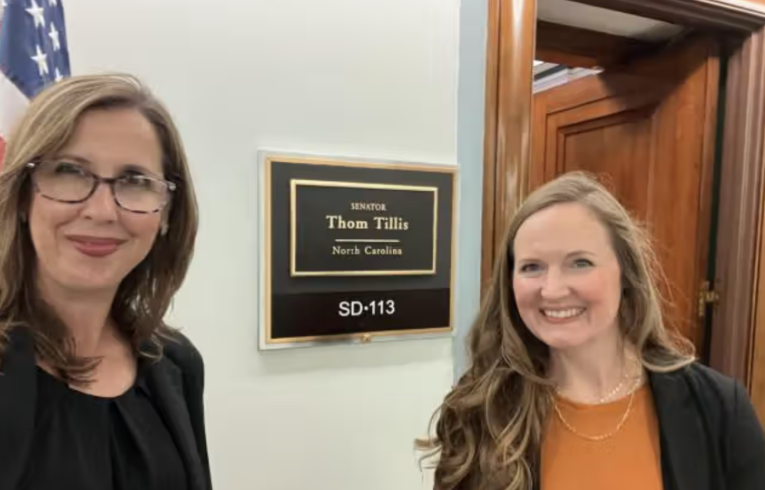
The week of September 11, Katie Bryant and Emily Donovan, passionate community leaders in NC, along with other National PFAS Contamination Coalition (NPCC) members, traveled to Washington D.C. and met with federal decision makers, including NC Senator Thom Tillis. The pair sought to push back on recently proposed legislation from the U.S. Senate Committee on Environment and Public Works that would narrow the legal definition of PFAS by excluding fluoropolymers, halving the number of federally “recognized” chemicals. “Our goal was to educate the staffers that their proposed definition is the opposite of what everyone else is doing”, said Emily. “It goes against what 18 states have already decided–that a PFAS chemical is one with one fully fluorinated carbon atom.”
Several community members from highly contaminated areas joined the NPCC to share their stories about how PFAS exposure has fundamentally altered their everyday lives. Among the many representatives they met with over the course of two days, one stood out. Jonathan Black, Senior Director for Chemical Safety and Plastic Pollution Prevention at the White House Council on Environmental Quality cried after community members shared their deeply personal stories. For Katie, this underscored the importance of connecting lawmakers with impacted community members. She said that, “directly impacted residents being able to tell their own stories in their own words, is incredibly powerful. We saw the benefit in real time.”
When asked about how they felt their message was received, Katie said, “I think it was received well, but it felt like a lot of staffers had an emotional wall up. I think there were some very impactful stories shared. I loved when we would go into a meeting and the person we were meeting with was already familiar with our concerns.” To that, Emily added, “It highlights the increased awareness of PFAS and GenX in the past 5 years. I no longer have to explain the importance of this topic anymore. Now it’s why these certain actions matter. There’s so many more communities across the nation that are raising this issue now, not just in highly contaminated areas.
The group hopes that their testimonies will help guide the committee in the right direction, but from here it is a waiting game. In closing, Emily said, “I think our visit was powerful and impactful, but it’s capitol hill, so we won’t really know unless there’s movement on the bill. We will remain vigilant. Overall, we wanted to send the message that their actions are being paid attention to by constituents.”

Katie L. Bryant holds her Bachelors degree in Microbiology with a minor in Chemistry. She is a trained Microbiologist with a focus in academic biomedical research, vaccine manufacturing, and quality assurance. She moved to Pittsboro, North Carolina in 2011 as a military spouse, where she started her family and later learned the truth behind Pittsboro’s secret water crisis. Immersing into citizen activism, she became the chair of the Pittsboro Water Quality Task Force from 2019 to 2020, and after continued inaction within the local government co-founded Clean Haw River alongside fellow Biologist Dr. Jessica Merricks. Since, she has been on a growing mission to bring awareness, understanding, and action to Pittsboro’s drinking water crisis.

Emily Donovan is co-founder of Clean Cape Fear, a grassroots community group that formed in 2017 after learning DuPont/Chemours contaminated North Carolina’s drinking water supply for over 40 years with toxic PFAS. She helped organize and co-host two screenings of the movie, Dark Waters, in Wilmington and Raleigh featuring special guest, Mark Ruffalo–both events resulted in NC’s Attorney General suing DuPont/Chemours for natural resource damages and NC’s General Assembly filing a historic amount of PFAS bills during the 2021-2022 legislative session. She helped secure reverse osmosis filling stations for 49 public schools impacted by PFAS contamination in Brunswick and New Hanover counties. She recently filed a complaint with the United Nations about human rights violations from PFAS contamination in NC drinking water and continues to pressure lawmakers and regulators for quicker responses to our growing PFAS public health crisis.
Updates From East Carolina University (ECU) and PFAS Immunotoxicity Studies

Biomedical Project 2 in the DeWitt Lab at Oregon State University (previously at East Carolina University) is focused on the mechanisms by which PFAS exposure affects B cell development and antibody production. So far we’ve found that B cells exposed to PFAS in vivo do not use their energy reserves in the same way as B cells that have not been exposed. This leads to shifts in B cell subsets along the developmental pathway from a naïve B cell to an antibody secreting plasma cell. We think that PFAS change mitochondria so that they are less flexible in responding to the changing energy demands that B cells experience as they develop. We hope that by figuring out this mechanistic pathway we can explore options for keeping B cells healthy so that they can respond appropriately when they are challenged with a vaccination, for example. Although the DeWitt Lab has changed locations from ECU to Oregon State University (as of October of 2023), the work will still continue!
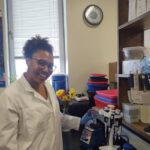
Krystal Taylor, a trainee from the DeWitt Lab at ECU, passed her dissertation defense with flying colors and is now a Senior Regulatory Affairs Associate at Kenvue, a company that produces well-known brands within the self-care, skin health and beauty and essential health areas. Dr. Taylor is applying her toxicology training to ensure that products within these categories meet appropriate standards for safety across the globe. Her training opportunities within the Superfund Center and the greater Superfund Research Program were essential for her career development. She also has published one paper from her dissertation research and has two more in the pipeline!
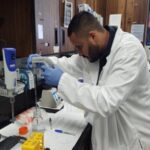
The DeWitt Lab also hosted a K.C. Donnelly extern this summer. Nobel Hernández Otero, a doctoral candidate in social determinants of health from the Universidad de Puerto Rico, spent a week in the DeWitt Lab learning how to perform laboratory toxicity assays. Nobel is a social scientist who is interested in communicating health risks about PFAS exposure to pregnant people in Puerto Rico. As a social scientist, he felt that he needed a better grasp of the science of PFAS to be a more effective communicator. What better way to learn science than to do science! Nobel became proficient with a pipettor and his standard curves were among the best! He will be presenting on his entire K.C. Donnelly award at the 2024 SRP Annual Meeting!
PERSONNEL UPDATES
Jamie DeWitt Named New Director of the Environmental Health Sciences Center at Oregon State University’s College of Agricultural Sciences

Following a national search, Oregon State University’s College of Agricultural Sciences has named Jamie DeWitt (Project 2 and Admin Core -Research Translation) as the director of the Environmental Health Sciences Center (EHSC). Most recently, she was a professor at the Department of Pharmacology & Toxicology at the Brody School of Medicine at East Carolina University (ECU). There she led ground-breaking research funded by the Department of Defense, the NIEHS, and the U.S. Environmental Protection Agency, along with numerous state and philanthropic organizations to advance research in immunotoxicology, neurotoxicology, and neuroimmunotoxicology.
The Superfund Welcomes New Trainees

Simone Georgy Sam is a Masters student in the Statistics program at NC State University. She will work under the guidance of Dr. Emily Griffith in the Data Management and Analysis Core (DMAC).

Zarin Tasnim is a PhD student in the Department of Civil, Construction, and Environmental Engineering at NC State University. She am working under the guidance of Dr. Detlef Knappe on Project 4, and her research focuses on understanding PFAS adsorption kinetics to granular activated carbon (GAC).

Macon Carroll is a second year PhD student at East Carolina University in the Biomedical Sciences Program with a concentration in Pharmacology and Toxicology in Jamie DeWitt‘s lab (Project 2).
We Also Wish Some of our Trainees All the Best on Their New Adventures

(2020-2023)
CAPTURE Core

(2020-2023)
Project 2

(2020-2023)
Project 2
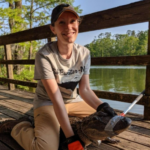
(2021-2023)
Project 3

Alexander Rodriguez
(2021-2023)
Project 4
SPOTLIGHTS
The Superfund Attended the 2023 SRP Annual Grant Recipient Meeting

Sarangi Joseph and Zarin Tasnim (Top Left)
Nate Wiecha (Middle Left)
Jane Hoppin (Bottom Right)
Detlef Knappe (Bottom Left)
The 2023 annual in-person meeting of the NIEHS Superfund Research Program (SRP) grant recipients and trainees was hosted by the University of New Mexico, in Albuquerque and NIH/NIEHS.
The event provided research progress updates of their SRP-supported research to other SRP grant recipients, trainees, SRP Program Staff, NIEHS Leadership, and federal/state/local end-users. This year’s meeting theme explored how utilizing team science can accelerate scientific discovery and solutions for those impacted by hazardous substances, with a special focus on engaging Indigenous Scientists and Community Members.
In addition, this in-person meeting fostered research translation, community engagement, data management and analysis, and training activities among SRP grant recipients and meeting participants. There were opportunities for SRP P42 Center Administrators to learn about NIEHS Grants Management topics specific to the SRP.
Jane Hoppin, Sarangi Joseph, and Hannah Starnes gave oral presentations of their studies and findings:
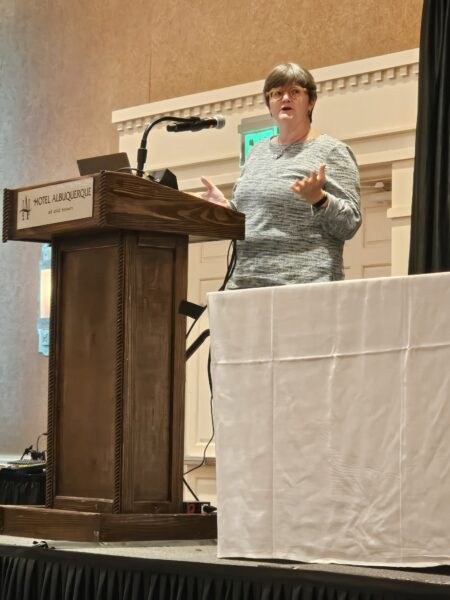
Project 1 – Jane Hoppin: New IARC Evaluation of PFOA and PFOS for Cancer
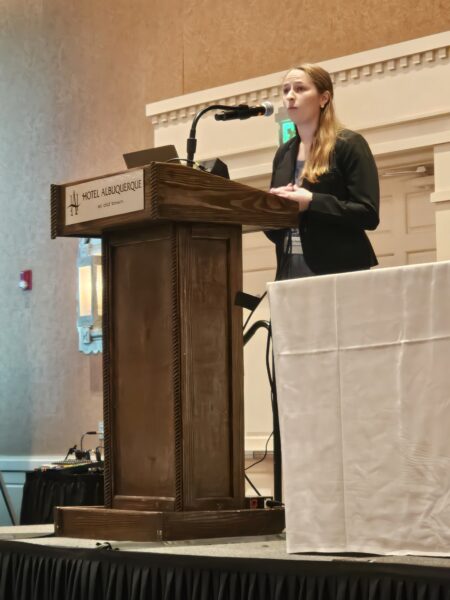
Project 3 – Hannah Starnes: In Vitro and In Silico Methods for the Assessment of Serum Albumin Interactions with PFAS
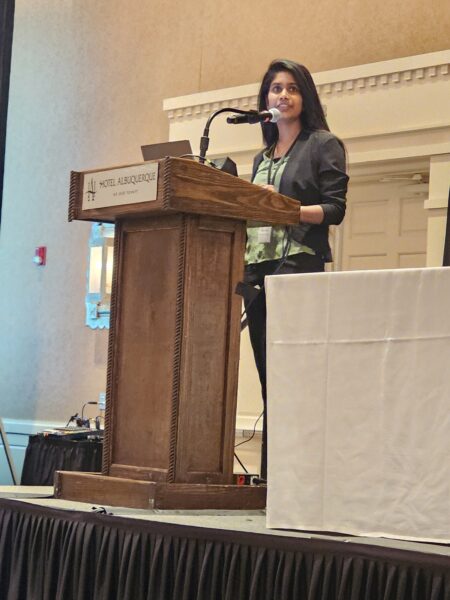
Project 4 – Sarangi Joseph: Mechanisms of PFAS sorption to activated carbon at sorption equilibrium
Several of our trainees and affiliates presented posters at the event:
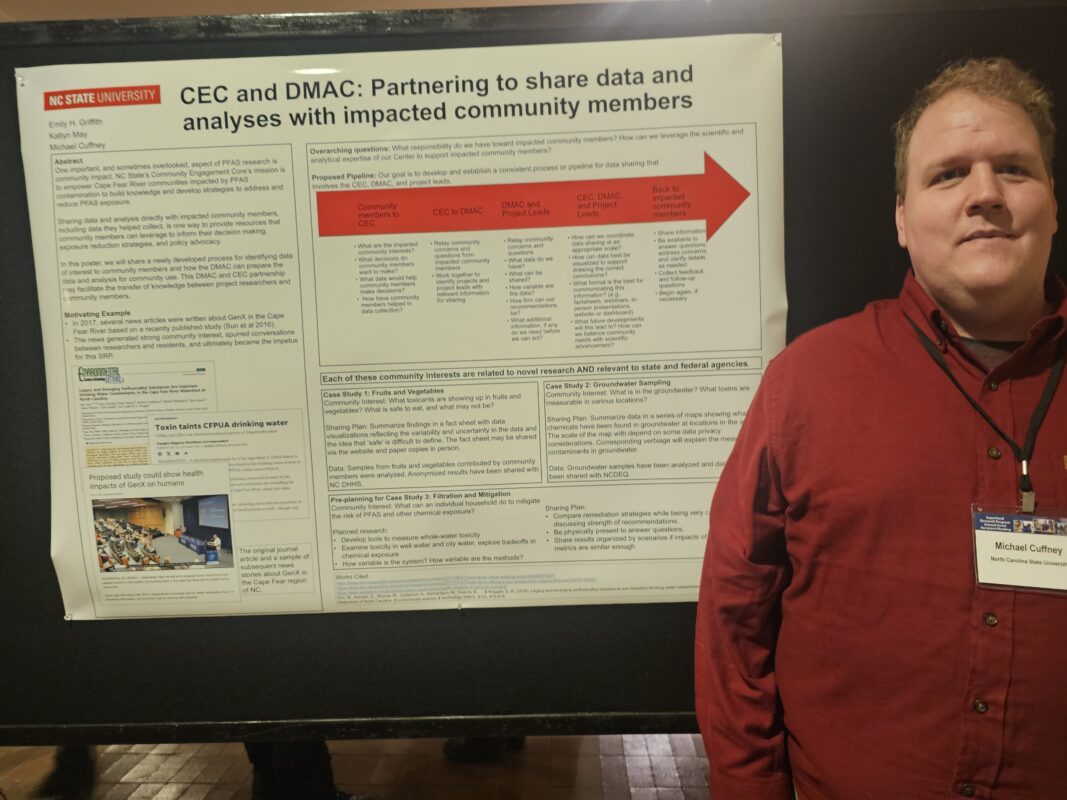
CEC and DMAC: Michael Cuffney presented on behalf of Katy May (CEC) and Emily Griffith (DMAC): CEC and DMAC: Partnering to share data and analyses with impacted community members
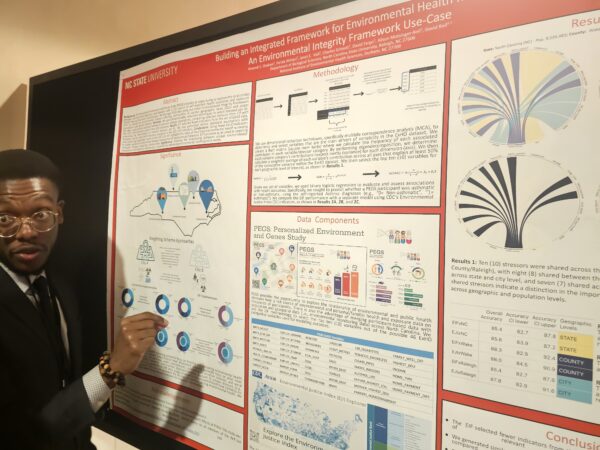
DMAC: Nnamdi Osakwe: Building an Integrated Framework for Environmental Health Modeling: An Environmental Integrity Framework Use-Case
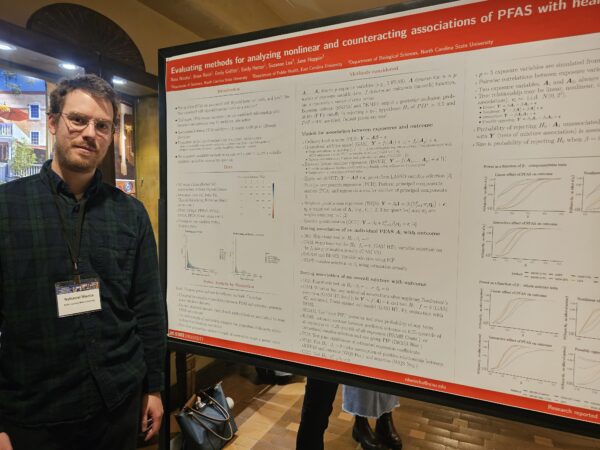
Project 1: Nathanial Wiecha: Evaluation of methods for analyzing nonlinear and counteracting associations of PFAS with health outcomes
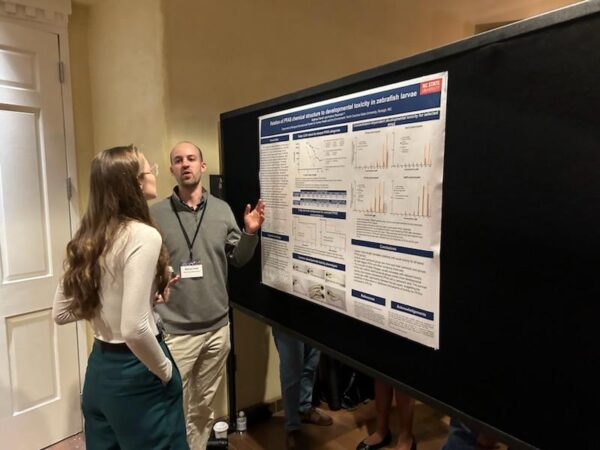
Project 3: Matt Farrell: Liver proteome changes in zebrafish in response to chronic low-dose PFAS exposure
Carolyn Mattingly Spoke at the Human Health Exposure Analysis Resource (HHEAR) Webinar

The Human Health Exposure Analysis Resource (HHEAR) hosted a series of webinars on several topics important to exposomics, a rapidly evolving approach in the contemporary biomedical sciences, which involves characterizing the totality of exposures and their effects on our health since conception.
The twelfth webinar in this series toke place Thursday, November 9, at 3 p.m. ET. Carolyn Mattingly, PhD, of North Carolina State University and Antony Williams, PhD, of the Center for Computational Toxicology and Exposure, United States Environmental Protection Agency, discussed how biomedical knowledge bases can help us understand the link between environmental exposures and health.
Knowledge bases are an essential resource in exposomics research. In this webinar, Dr. Carolyn Mattingly and Dr. Antony Williams discussed how knowledge bases such as the Comparative Toxicogenomics Database and The EPA Computational Toxicology (CompTox) Chemicals Dashboard can be utilized for advancing exposomics research.
Detlef Knappe Wins the 2023 Borchardt-Glysson Water Treatment Innovation Award

Every three years, the Michigan-based Borchardt Conference brings together a diverse group of engineers, scientists, public health specialists, and students to present and discuss the latest challenges and advances in water and wastewater technology. This event emphasizes applied research and real-life experience in environmental engineering and water utility operations, and we’re excited to participate later this month!
This year, the conference took place on May 23 – May 24 at the Rackham Building at the University of Michigan in Ann Arbor. Congratulations to the 2023 Borchardt-Glysson Water Treatment Innovation Prize winner, Dr. Detlef Knappe, who was honored at the conference and awarded a $10,000 cash prize. Dr. Knappe also gave a lecture at the conference on PFAS and other unregulated contaminants in the Cape Fear River Watershed of North Carolina, including community impacts and interventions to reduce human exposure. In addition to his distinguished work as a professor and research team leader to NC State University, Dr. Knappe serves as deputy director of NC State Center for Environmental and Health Effects of PFAS, is a member of NC State Center for Human Health and the Environment and has also collaborated with several water utilities in Michigan on PFAS removal from drinking water.
NIEHS Extramural Paper of the Month Spotlights Scott Belcher

Scott Belcher (Project 3) and trainees Kylie Rock and Hannah Starnes‘ study on PFAS Found in Blood of Dogs, Horses Living Near Fayetteville, N.C. was selected as the NIEHS Extramural Paper of the Month! The Extramural Papers of the Month are selected based on their important findings and potential for public health impact.
Dogs and horses may be important indicators of exposure to PFAS Companion animals and livestock could provide insight into human exposure to PFAS inside and outside the home, according to an NIEHS-funded study. The scientists identified elevated levels of PFAS in dogs and horses from Gray’s Creek, North Carolina — a neighborhood near a PFAS manufacturing plant.

The team recruited participants with well water PFAS contamination, following concerns raised by community members about the health of their pets. Then, they took blood samples from the participants’ animals — 31 dogs and 32 horses— to test for 33 types of PFAS.
Every single animal had at least one PFAS detected, with over half of dogs and horses having a minimum of 12 PFAS in their blood. However, the types of PFAS and concentrations of the chemicals differed between animals. For example, dogs that drank bottled water provided by their owners had higher levels of PFAS from indoor sources, such as paint and consumer products. Horses that lived outdoors and dogs that drank well water had higher levels of the PFAS compounds produced at the nearby plant.
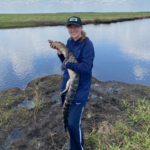
Within dogs, analysis revealed that concentrations of two types of PFAS were similar to the concentrations found in children from another North Carolina town, downstream of the PFAS manufacturing plant. The researchers also found changes in key proteins related to kidney and
liver function in the animals’ blood, which are known to be primary targets of PFAS toxicity in humans.
According to the authors, these findings suggest that dogs and horses may provide critical information about routes of exposure and potential PFAS toxicity, particularly during sensitive developmental windows such as during childhood.

Jamie DeWitt Presented at the NASEM Board on Agriculture and Natural Resources
Jamie DeWitt (Project 2 and Admin Core -Research Translation) presented Human health effects of PFAS exposure during the virtual NASEM Board on Agriculture and Natural Resources: Exploring linkages between soil health and human health meeting on May 16-17, 2023. This event focused on the following item in the committee’s statement of task: Information on the interactions of the soil microbiome with soil contaminants that pose risks to human health.
SRP Makes an Impact at Toxicology Research Symposium 2023

Seth Kullman (Project 2) gave the welcome at NC State’s annual Toxicology Research Symposium 2023. This symposium allows Students from the Toxicology Graduate Program to present their research to fellow colleagues. This is a student-led effort headed by the Toxicology Graduate Student Association (TGSA).
Several SRP trainees gave presentations at the symposium. Morgan Ritter (Project 2): Early disruption of vitamin D receptor signaling induces developmental behavior deficits in zebrafish; Matthew Farrell (Project 3): Behavioral alterations in zebrafish due to chronic PFAS exposure; and Ashley Connors (Project 2): Investigating the Impact of Per-And Polyfluoroalkyl Substances (PFAS) on Macrophage Phagocytosis.



Krystal Taylor Presented at a Joint RETCC Meeting and Defended Her Dissertation

Trainee Krystal Taylor with Project 2, presented “PFAS and Adaptive Immunity” at the joint NCSU-URI-HU Trainee Meeting on May 10th. NCSU’s RETCC, in coordination with URI’s STEEP RETCC, are holding several joint trainee meetings. There are several benefits for our attendees, including of course an opportunity to network with other trainees and postdocs from STEEP; learn about potential areas of collaboration, and new technologies; and, of course, an opportunity to practice giving talks in a friendly setting, and receive feedback from folks not directly involved in their specific area but with potentially valuable insights nonetheless.
Krystal also successfully defended her dissertation: Quantifying the impact of PFAS Exposure on B Cell Development and Antibody Production in July.
Matt Farrell Spoke at a SRP Risk e-Learning webinar

The NIEHS Superfund Research Program (SRP) sponsored a Risk e-Learning webinar series, hosted by CLU-IN, focused on research efforts to develop tools for sampling, monitoring, detecting, and characterizing per- and polyfluoroalkyl substances (PFAS) contamination. Matt Farrell, (Trainee in Project 3, Planchart Lab) presented during this webinar.
The three-part series will feature SRP-funded researchers and collaborators whose research focuses, in part, on understanding the distribution and fate of PFAS in the environment.
The second session, Tools for PFAS Site Characterization: Session II – PFAS Sources and Mapping, highlighted case studies featuring SRP research to understand PFAS sources and to predict fate and transport.
Toxicology Fall Newsletter Highlights Superfund Personnel

Jeffrey Yoder‘s (Project 2) lab was the featured lab. The Yoder Lab of Comparative Immunology and Immunotoxicology studies mediators of innate immunity. The primary goals of the Lab are to: 1) study the genetic and functional evolution of innate immune receptors; 2) identify novel mediators of innate immunity; and 3) understand the immunotoxicological effects of environmental chemicals.
Recently, the Lab has begun working on PFAS compounds as part of the NC State Superfund Research Program. Through a combination of in vivo studies using zebrafish and in vitro studies using human cell lines and primary cells, the project aims to understand how these compounds impact the innate immune system. The Lab has shown that exposure to PFAS in these systems suppresses the respiratory burst – an important innate immune process induced by neutrophils in response to pathogens. Defects in this system increase susceptibility to infection. Ongoing studies aim to determine how PFAS exposure impacts other aspects of the innate immune system such as macrophage phagocytosis, phagocyte energy utilization and cytokine production. Trainees of the Lab include:

Ashley Connors graduated from Pacific Lutheran University in 2017 with a BS in Biology and Chemistry with a minor in Environmental Studies. After graduating, she worked at Oregon Health & Science University where her research focused on hypothalamic neuronal circuits involved in reproduction and other homeostatic functions. Ashley is a PhD and works with Jeffrey Yoder (Project 2).

Rajamanickam
Britney Paul Rajamanickam graduated from NC State in December 2022 with a degree in Biology. While her undergraduate research gave her the opportunity to work with Dr. Jane Hoppin (Project 1), she is open to many different research opportunities and using her lab rotations to explore different areas of toxicology. While she may have finished high school and college in NC, she is a true Midwesterner having grown up in Wisconsin. How deep do her midwestern roots run? Well, she misses Culvers (who wouldn’t?) and has a passion for cheese curds (with ranch).

Hannah Starnes worked as a lab assistant/instructor for the Endocrine-Disrupting Chemicals: Hazards and Opportunities class this past May & June at Woods Hole. Dr. Scott Belcher (Project 3) and Dr. Heather Patisaul are very involved in the teaching of this course.

Zach McLean is originally from Lenoir, NC. After earning a BS in Human Biology from NC State, he decided he wasn’t done with school. While working on his Master’s in Physiology (NCSU), he worked with Dr. Scott Belcher (Project 3) on an independent research project and found his passion for Toxicology. Zach states his latest interest is “Tears of the Kingdom” and he is a collector of ALL the tools needed for various projects around the house, but he will not disclose whether this is intentional or not.
NIEHS Trainee Spotlight – Nnamdi Osakwe

Nnamdi Osakwe is a trainee at the North Carolina State University (NCSU) SRP Center. Osakwe is part of the center’s Data Management and Analysis Core (DMAC).
Tell us about your work with the NCSU SRP Center.
The purpose of my research is to understand the relationship between environmental exposures and human health outcomes in populations disproportionately exposed to poor environmental quality and social inequities, or environmental health disparities. By using bioinformatic techniques —collecting, storing, and analyzing biological data — I hope to provide affected communities and policymakers with data on environmental quality and its effects on human health.
How did you become interested in this work?
As an undergraduate at North Carolina Central University (NCCU), I had the opportunity to work under the guidance of ClarLynda Williams-DeVane to use bioinformatics to study the health disparities surrounding diseases like asthma, diabetes, and obesity. Recognizing the knowledge gaps in health disparities research and the lack of diverse researchers addressing these problems fueled me to pursue this area further.
You recently received a Research Supplement to Promote Diversity in Health-Related Research. Tell us about it.
This is a supplement to the center’s DMAC grant and will provide me with the necessary resources to adequately target and study areas disproportionally exposed to contaminants of top priority to SRP, like PFAS. Receiving this supplemental grant confirmed and validated that my research is essential and meaningful to SRP — and to NIEHS as a whole.
Tell us about a project that excites you.
I am collaborating on a project to study the relationship between green spaces and their effects on biological aging, one of the risk factors for many human diseases. I get to combine many of my interests in this project: bioinformatics, environmental health, public health, and health disparities. I am thankful I can pursue my interests while helping to make positive change for often-ignored communities.
What is one piece of advice that you want to share with other SRP trainees?
Patience is key. There is no doubt that graduate school will test your patience in many ways but learning to persevere and take challenges one step at a time has helped me get through this experience. Although it can seem long and difficult, consistent, and gradual progress will eventually lead you to achieve your goals.
NIEHS Trainee Spotlight – Hannah Starnes

Hannah Starnes is a trainee in Dr. Scott Belcher‘s lab (Project 3). Hannah was spotlighted by NIEHS for her work in the Superfund Center.
What is the focus of your research at the NCSU SRP Center?
I study whether different human and animal proteins can bind to PFAS, and how strong those binding interactions are. More specifically, my research aims to uncover how the same protein in different species might bind to PFAS and to develop machine learning approaches that can predict protein interactions for thousands of untested PFAS compounds.
How did you become interested in this work?I became interested in lab work and human health research through a biomedical sciences program at my high school, but I had always been passionate about environmental health and climate change protections. I pursued research in both neuroscience and environmental studies in my undergraduate career, and eventually discovered toxicology. This led to my research in how chemicals impact the brain, and in the distribution and uptake of PFAS into tissue.
Tell us about a recent award and what it means to you.
Recently, I was awarded the NCSU Toxicology Founder’s Fellowship, which granted funding for my travel to Woods Hole, Massachusetts, to participate as a teaching assistant in the Marine Biological Laboratory Endocrine Disrupting Chemicals (EDCs): Hazards and Opportunities course. This award allowed me to improve my science communication and instruction of laboratory methods, attend courses taught by faculty studying EDCs, and gain hands-on experience in new techniques related to endocrine toxicology.
What factors have contributed most to your growth as a researcher throughout your time as an SRP trainee?
Collaboration with a diverse group of inspiring scientists and mentors has contributed the most to my development as a researcher. I have been so lucky to work with and receive training from many talented people, spanning the fields of toxicology, analytical chemistry, machine learning, endocrinology, epidemiology, and zoology. All of these scientists have unique perspectives that have broadened my thinking and deepened my motivation to do impactful work.
What is one piece of advice that you have for other SRP trainees?
My advice to other SRP trainees would be to challenge yourself to step out of your comfort zone — try working on projects that are out of your wheelhouse or seek advice from people with different expertise. You will learn a lot and may end up loving something totally new.
Susie Proctor was Highlighted in the NC PFAS Network Newsletter

Brown, Susie Proctor,
Nadine Kotlarz, Katy May
Susie Proctor, an affiliate of our Superfund Center, presented at the International Society of Exposure Science (ISES) 2023 Annual Meeting. Her presentation was on “Perfluoroalkyl Ether Acids in Dust From Households Near a Fluorochemical Manufacturing Facility, Fayetteville, North Carolina”. Susie is currently a research assistant on the GenX Exposure Study at the Center for Human Health and the Environment at NC State. Click HERE to read more.
Ashley Connors is a Co-Winner of the Young Scholars Award

Ashley Connors, trainee in the Yoder Lab (Project 2) is a recent co-winner Young Scholars Award from NC State’s Comparative Medicine Institute. The proposal, titled “Developmental Toxicity Assessment of Fluorinated and Fluorine-free Firefighting Foams using the Zebrafish Model,” was written in collaboration with fellow graduate student Fatema Tuj Jahura in the Gluck and Ormond Labs (College of Textiles). This $9,000 award provides summer research funding for an undergraduate student, co-mentored by Ashley and Jahura, along with a research supply budget for the proposed project and supplemental funds towards each of the graduate students’ dissertation projects.
Hannah Starnes Receives an Honorable Mention

Trainee Hannah Starnes, (Project 3, Scott Belcher‘s lab), received a Graduate Honorable Mention for the College of Sciences Student Excellence Awards.
RECENT PUBLICATIONS
- Baker, Erin S., Kirkwood-Donelson, Kaylie, Dodds, James, Schnetzer, Astrid, Hall, Nathan (2023, October 25). Uncovering per- and polyfluoroalkyl substances (PFAS) with nontargeted ion mobility spectrometry–mass spectrometry analyses. Science Advances. https://doi.org/10.1126/sciadv.adj7048
- Boatman, A. K., Chappel, J. R., Polera, M. E., Dodds, J. N., Belcher, S. M., & Baker, E. S. (2023, September 5). Assessing Per- and Polyfluoroalkyl Substances (PFAS) in Fish Fillet Using Non-Targeted Analyses. (Preprint: https://doi.org/10.1101/2023.09.01.555938)
- Chappel JR, King ME, Fleming J, Eberlin LS, Reif DM, Baker ES. 2023. Aggregated molecular phenotype scores: Enhancing assessment and visualization of mass spectrometry imaging data for tissue-based diagnostics. Analytical Chemistry. 95(34):12913-12922. doi:10.1021/acs.analchem.3c02389 PMID:37579019
- Cuffney, M., Wilkie, A., Kotlarz, N., Knappe, D., Lea, C., Collier, D., DeWitt J., Hoppin J. (2023, September 4). Factors associated with per- and polyfluoroalkyl substances (PFAS) serum concentrations in residents of New Hanover County, North Carolina: The GenX exposure study. https://doi.org/10.1016/j.envres.2023.117020.
- Efromson J, Ferrero G, Bègu A, Doman TJJ, Dugo C, Barker A, Saliu V, Reamey P, Kim K, Harfouche M, Yoder JA. 2023. Automated, high-throughput quantification of EGFP-expressing neutrophils in zebrafish by machine learning and a highly-parallelized microscope. BioRxiv. 553550 [Preprint, posted August 18, 2023]. PMID: 37645798. PMCID: PMC10462042. Available from: https://doi.org/10.1101/2023.08.16.553550.
- Phelps D, Palekar AI, Conley HE, Ferrer G, Driggers JH, Linder KE, Kullman SW, Reif DM, Sheats MK, DeWitt JC, Yoder JA. 2023. Legacy and emerging per- and polyfluoroalkyl substances suppress the neutrophil respiratory burst. J Immunotoxicol. 20(1): 2176953. PMID: 36788734. PMCID: PMC10361455. DOI: 10.1080/1547691X.2023.2176953.
- Rock KD, Polera ME, Guillette TC, Starnes HM, Dean K, Watters M, Stevens-Stewart D, Belcher SM. 2023. Domestic dogs and horses as sentinels of per- and polyfluoroalkyl substances exposure and associated health biomarkers in Gray’s Creek North Carolina. Environmental Science & Technology. 57(26):9567-9579. doi:10.1021/acs.est.3c01146 PMID:37340551
- Taylor KD, Woodlief TL, Ahmed A, Hu Q, Duncker PC, DeWitt JC. 2023. Quantifying the impact of PFOA Exposure on B cell development and antibody production. Toxicol Sci. 194(1): 101-108. PMID: 37162486. PMCID: PMC10306397. DOI: 10.1093/toxsci/kfad043.
- Wallis Dylan J., Kotlarz Nadine, Knappe Detlef R.U., Collier David N., Lea C. Suzanne, Reif David, McCord James, Strynar Mark, DeWitt Jamie C., Hoppin Jane A. 2023. Estimation of the Half-Lives of Recently Detected Per- and Polyfluorinated Alkyl Ethers in an Exposed Community. Environmental Science & Technology DOI: 10.1021/acs.est.2c08241. Manuscript No.: es-2022-08241e (10.1021/acs.est.2c08241)
- Zhang C, Tang T, Knappe DRU. 2023. Oxidation of Per- and Polyfluoroalkyl Ether Acids and Other Per- and Polyfluoroalkyl Substances by Sulfate and Hydroxyl Radicals: Kinetic Insights from Experiments and Models. Environ Sci Technol, online ahead of print. PMID: 37223990. NIHMS: NIHMS1929684. DOI: 10.1021/acs.est.3c00947.
PFAS IN THE NEWS
UN Researchers Say Chemours Disregarded Human Rights When Dumping Waste into Water Supply
A group of independent researchers appointed by the United Nations Human Rights Council has accused Chemours of disregarding human rights for contamination of the water supply from the Cape Fear River. In a series of letters sent to leaders of Chemours and its parent company, DuPont, the group said it was alarmed by “the company’s blatant disregard for human rights and environmental protections.” Chemours has admitted to dumping forever chemicals, also known as PFAS, into the Cape Fear River for years, contaminating the drinking water supply for hundreds of thousands of people. Click HERE to read more.
New IARC Evaluation of PFOA and PFOS for Carcinogenity

Jane Hoppin, Project 1, was part of the panel that reviewed PFOA and PFOS for carcinogenicity. As a result, PFOA was classified as a Group 1 carcinogen (Human carcinogen) based on sufficient bioassay evidence and strong mechanistic evidence (epigenetics and immune impacts). The Human cancer evidence was regarded as limited, but some evidence for kidney and testicular cancer.
And, PFOS was classified as Group 2b (possible human carcinogen) based on limited bioassay evidence and strong mechanistic evidence. Human cancer evidence for PFOS was limited. Click HERE to read more.
The PFAS Puzzle: Lessons on Health


The emergence of PFAS has epidemiologists and toxicologists working to understand the health impacts. Researchers in North Carolina are on the leading edge of the science and discuss what is known about human health impacts. Jane Hoppin (Project 1) and Jamie DeWitt (Project 2) discuss the effects of PFAS on your health. To listen to the podcast, click HERE.
8 New Types of ‘Forever Chemicals’ Found in River Linked to US Cancer Cluster

Per Erin Baker, CAPTURE Core Director and Associate Professor of Chemistry at the University of North Carolina at Chapel Hill, despite decades of monitoring, PFAS can be challenging to identify. To validate identification, it’s critical to check that your analyses match those of a “standard” sample of the substance that you either purchase or synthesize, says Erin Baker, an associate professor of chemistry at the University of North Carolina at Chapel Hill and an author on the new study. But standard samples don’t exist for most PFAS yet, and many are too difficult or expensive to synthesize in labs. Creative techniques give researchers more power to identify the mysterious characteristics of these chemicals, Baker says.
Kaylie Kirkwood-Donelson, one of the main contributors on the paper. Kirkwood-Donelson, now a chemist at the National Institute of Environmental Health Sciences, was a graduate student and research assistant at North Carolina State University’s Center for Environmental and Health Effects of PFAS while conducting this work. Click HERE to read the full article.
Nearly half of the tap water in the US is contaminated with ‘forever chemicals,’ government study finds

CNN – Almost half of the tap water in the US is contaminated with chemicals known as “forever chemicals,” according to a new study from the US Geological Survey. The number of people drinking contaminated water may be even higher than what the study found, however, because the researchers weren’t able to test for all of these per- and polyfluorinated alkyl substances, or PFAS, chemicals that are considered dangerous to human health.
“There’s been almost no place scientists have looked where they have not found PFAS,” said Jamie DeWitt, (Project 2), a professor of pharmacology and toxicology in the Department of Pharmacology & Toxicology at East Carolina University who was not involved in the new study.
PFAS are found in hundreds of household items. The chemicals are used to make carpets and clothes stain-resistant. They keep food from sticking to pans and food packaging, and they’re good at keeping grease and water from soaking through. PFAS are in mobile phones, commercial airplanes and low-emission vehicles, in the foods you can buy at the farmers market or the grocery store, and in rainwater and dental floss. They’re even in the dust that collects in your home. A 2019 study suggested that PFAS chemicals could be found in 98% of the US population. Click HERE to learn more.
‘Forever chemicals’ found in central North Carolina, study finds

WRAL – A national study found PFAS, also known as “forever chemicals,” in the parts of central North Carolina. Of the 11 sites tested in the state, it found the presence of forever chemicals at four of them – including downtown Cary and along the Orange-Alamance county line near Saxapahaw.
Katy May (CEC) is director of community engagement for the Center for Environmental and Health Effects of PFAS. “The more we learn about them, the more we realize they’re everywhere in our environment,” May said. “They’re in our drinking water, in our soil, in the air, and then they end up in our bodies.” The Center for Environmental and Health Effects of PFAS looks at different ways PFAS get into the environment, health impacts and way to remediate PFAs. May said she’s been researching the topic since about 2017. Click HERE for more information.

PFAS in Drinking Water: Responding to Community Concerns Podcast
Jane Hoppin, Sc.D. (Project 1), discusses, in a new podcast, how she helped launch a study to address North Carolina residents’ concerns following the discovery of PFAS in their drinking water. She also provides tips to reduce one’s exposure to PFAS in drinking water. Click HERE to listen to the podcast.
Tracey Woodlief Discusses Firefighters Exposure to PFAS

Tracey Woodlief, Project 2 in the DeWitt lab, discusses firefighter health risks when exposed to PFAS. Firefighters can face many dangers on the job, including exposure to what’s known as PFAS, referred to as forever chemicals. The North Carolina Firefighters’ Alliance announced new resources at the NC Mid-Winter Chiefs’ Conference at the Concord Convention to bring awareness and prevention for firefighters. PFAS particles are said to play a part in firefighting. Click HERE to read more.
“PFAS are found in the turnout gear of firefighters as well as in firefighting foam and so there’s multiple ways of being exposed to PFAS if you’re a firefighter. PFAS are associated with health risks such as cancer,” said Brody School of Medicine Pharmacology and Toxicology Researcher, Tracey Woodlief. Click HERE to read more.
WRAL Documentary: Forever Chemicals: North Carolina’s Toxic Tap Water
This documentary explores the damage caused by massive amounts of toxic chemicals dumped into the Cape Fear River. Jamie DeWitt (Project 2) discusses the how these chemicals effect small children and adolescence. The GenX study by Jane Hoppin (Project 1) is also highlighted as health problems including cancer and birth defects are attributed to the toxic drinking water families are dependent on. Scott Belcher‘s (Project 3) recent study on pets and livestock, found PFAS in the blood of dogs and horses in the area, – including dogs that only drank bottled water is also discussed. Click HERE to watch the documentary.



Cape Fear Residents from the Skarure Woccon tribe worry about river contamination and what that means for their cultural traditions
Leaders of the Skarure Woccon tribe are encouraging members to avoid customary activities, such as eating fish from the Cape Fear River, due to health concerns. While there is no definitive evidence about the health risks PFAS pose to humans, there is mounting research that suggests links between extended exposure to forever chemicals and weaker antibody responses against infections, elevated cholesterol levels, decreased infant and fetal growth, and kidney and testicular cancer in adults.
Jane Hoppin (Project 1) who is leading the GenX Exposure Study, a large effort to look at the health effects in people exposed to PFAS, presented information about the study and answered questions. Scott Belcher (Project 3) discussed subsistence fishing. Currently, Scott is studying fish that are primarily located in the upper Cape Fear. Katy May (CEC Core) also discussed filtration systems and the challenges in securing and distributing the systems and how the City of Wilmington is filtering the municipal water supply. Click HERE to read more.





Jane Hoppin and Katy May Discuss Cape Fear River’s ongoing PFAS problem
Jane Hoppin, Project 1, and Katy May, Community Engagement Core were in Wilmington discussing Cape Fear River’s ongoing PFAS problem with community organizations, residents, researchers, activists and legal experts who came to discuss and answer questions about PFAS contamination in the public water supply and private drinking wells and to explore options, including political ones, available to address the contamination in their water and their bodies. Click HERE to read more.


Jane Hoppin (Project 1) and colleagues, including East Carolina University epidemiologist Suzanne Lea, launched the GenX Exposure Study to answer some of the many questions about the potential health impacts of the chemicals on humans.
Navassa, a predominantly Black community, is in Brunswick County and gets its drinking water from the Cape Fear River, as does its neighbor Wilmington, which is about six miles southeast. That makes the town’s residents prime candidates to join the GenX Exposure Study, a multisite study where environmental health researchers are examining the blood of people who’ve been exposed to per- and polyfluoroalkyl substances (PFAS), which have contaminated waterways throughout the state. Click HERE to read more.
Wilmington woman shares results from NC State GenX Exposure Study

Researchers from NC State University were in Wilmington back in 2021 collecting blood samples from residents to study the levels of forever chemicals in humans and the impacts the chemicals have on our overall health. Researchers from the GenX Exposure Study, took blood samples from a thousand people across the state, looking at the levels of forever chemicals, including PFAS, in their bodies and the results have been arming to residents.
“All of these chemicals are measured in all the people in the United States, except that the levels for people in the Cape Fear River Basin are much higher,” Dr. Jane Hoppin (Project 1), principal researcher for this study, said. “So, this summer and fall, we’re going to re-contact, all those 1000 people who enrolled, and we’re going to bring them in again to collect another blood sample. So, we’ll measure PFAS again, we’ll also measure some of the clinical outcomes like thyroid, hormones, lipids, comprehensive metabolic panel.” Click HERE to read more.
Scientists continue GenX study in Fayetteville as World Health Organization says some PFAS carcinogens

A North Carolina-based research study on exposure to GenX and related chemicals among people living in the Cape Fear River Basin is analyzing new blood samples from four communities with water supplies heavily contaminated with PFAS, including Fayetteville, Pittsboro, New Hanover County and Brunswick County.
Meanwhile, international experts convened in November by the World Health Organization have labeled two legacy types of PFAS — PFOA and PFOS — as carcinogenic and possibly carcinogenic to humans, respectively.
Dr. Jane Hoppin is the study’s principal investigator and director of the Center for Human Health and the Environment at NCSU.
“Our overall focus is we want to understand what’s happening throughout the Cape Fear river basin and also look at how the exposures differ in the groundwater community compared to people drinking surface water,” Hoppin told CityView Magazine. Click HERE to read more.
Do You Have PFAS in Your Home?

Scott Belcher (Project 3) discusses some of the items that contain PFAS that are in your home. PFAS chemicals exist in more than 12,000 forms and have been linked to a long list of negative health effects. ‘Forever chemicals will be with us, well, forever. The best step now, say the experts, is to eliminate them from products as fast as possible and quit making the problem worse. “They are going to be with us as a legacy,” says Belcher. “And we keep adding to that pile of pollution we’re living in.” Click HERE to read more.
How Much Can a Water Filter Do?

Lead, bacteria and PFAS are among the contaminants cropping up in drinking water. Most water treatment plants are not set up to remove more modern contaminants, such as PFAS, pharmaceutical drugs and endocrine disrupting chemicals, said Detlef Knappe (Admin Core and Project 4), a professor of civil, construction and environmental engineering at North Carolina State University, who was one of the first to publish on the Wilmington PFAS problem. “Often, things go wrong because of just underinvestment into this type of infrastructure,” Dr. Knappe said. “The rate at which we’re replacing the distribution system pipes in the network is not keeping up with the rate at which the system really needs to be maintained.”
Home filters appear to work decently well for PFAS and can now be NSF/ANSI Standard 53 certified for some of those chemicals, too. In a study published in 2020, Dr. Knappe and his co-authors found that, on average, pitcher and refrigerator filters that use activated carbon reduced PFAS levels by about 50 percent. More advanced filtration systems that use a process known as reverse osmosis were over 90 percent effective, but they are much more expensive and waste a significant amount of water. Sometimes filters can cause more harm than good. Click HERE to read more.
Many soft contact lenses in US made up of PFAS, research suggests

Many soft contact lenses in the US are largely made up of compounds called fluoropolymers that are by definition PFAS “forever chemicals”, new research suggests. Testing of 18 popular kinds of contact lenses found extremely high levels of organic fluorine, a marker of PFAS, in each.
“You could consider [the lenses] almost pure PFAS,” said Scott Belcher (Project 3), a North Carolina State University researcher and scientific adviser on the contact lens testing. Read more HERE.
PFAS Found in Blood of Dogs, Horses Living Near Fayetteville, N.C.
In a new study, researchers from North Carolina State University detected elevated PFAS levels in the blood of pet dogs and horses from Gray’s Creek, N.C. – including dogs that only drank bottled water. The work establishes horses as an important sentinel species and is a step toward investigating connections between PFAS exposure and liver and kidney function in dogs and horses.
The study included 31 dogs and 32 horses from the community, and was conducted at the behest of community members concerned about their pets’ well-being. All of the households in the study were on well water, and all of the wells had been tested and deemed PFAS contaminated by state inspectors. Click HERE to read more.
Scott Belcher (Project 3), Kylie Rock (Trainee – Project 3), and Hannah Starnes (Trainee – Project 3) were authors of this abstract.



Scott Belcher is quoted in Chemistry World

Scott Belcher (Project 3) discusses the veil of confidentiality that companies use to hide documents related to PFAS harming their own employees. ‘Sometimes the veil of confidential business information really makes public health assessment difficult,’ Scott tells Chemistry World. ‘If there were known toxicities to the scale that this seems to reflect, it could have potentially been a great service to public health if alternatives had been found to these chemicals,’ Belcher says. ‘We can’t make good decisions without the data.’ Click HERE to read more.
Jane Hoppin interviewed by Atlanta reporter about PFAS contamination in Rome, GA

Jane Hoppin (Project 1) is one of three scientists recommending following the NASEM recommendations on clinical follow-up for PFAS exposed people. For decades, the Oostanaula River that supplied Rome’s drinking water was contaminated with perfluoroalkyl (PFAS). The chemical group is linked to serious illness, including cancer. City officials switched to a different water source in 2017, but many residents have always wondered how the contaminated water impacted them prior to the disclosure.
Jane pointed to new recommendations released by the National Academies of Sciences, Engineering, and Medicine in 2022, which called for more testing of people with a history of known elevated PFAS exposure. “[I]f testing reveals PFAS levels associated with an increased risk of adverse effects, patients should receive regular screenings and monitoring for these and other health impacts,” the report said. Click HERE to read more.
CENTER EVENTS: PAST, PRESENT, AND FUTURE
PRESENT AND FUTURE
JANUARY
JANUARY 16 – Toxicology Seminar Series – Jane Hoppin
4:00-5:00 pm EST, Toxicology Building. Dr. Jane Hoppin, Professor – Biological Sciences at NC State University, will be the guest speaker and will give a seminar on: “The IARC Process of Evaluating Potential Carcinogens: Recent Findings for PFOA and PFOS”.
The Toxicology Seminar Series is sponsored by a NIEHS T32 training grant “Molecular Pathways to Pathogenesis in Toxicology’. TGSA Career Exposures, includes a chance for all students to meet with the speaker. To learn more, click HERE.
JANUARY 23-25 – The Science of PFAS: Chipping Away at the Details
7:30-5 pm EST, Sheraton Raleigh Hotel. The research around per- and polyfluoroalkyl substances (PFAS) continues to inch forward through the talents of all sectors working together to find answers and develop solutions. A&WMA continues this premier conference to bring together scientists, researchers, academics, practitioners, regulators, and the regulated community to further the conversation on the current state of PFAS science and solutions for the future. Click HERE for more information.
See More Future Events HERE
PAST EVENTS
JANUARY
JANUARY 10 – Advancing the Science of PFAS Mixtures Assessment
3:00-4:30 pm EST, Webinar. Dr. Jason Lambert of the US EPA Office of Research and Development (ORD) presented “Advancing the Science of PFAS Mixtures Assessment” that discussed features of a draft “Framework for Estimating Noncancer Health Risks Associated with Mixtures of Per- and Polyfluoroalkyl Substances (PFAS).” The framework was developed by the US EPA ORD and Office of Water. Click HERE to register and learn more.
See More Past Events HERE
